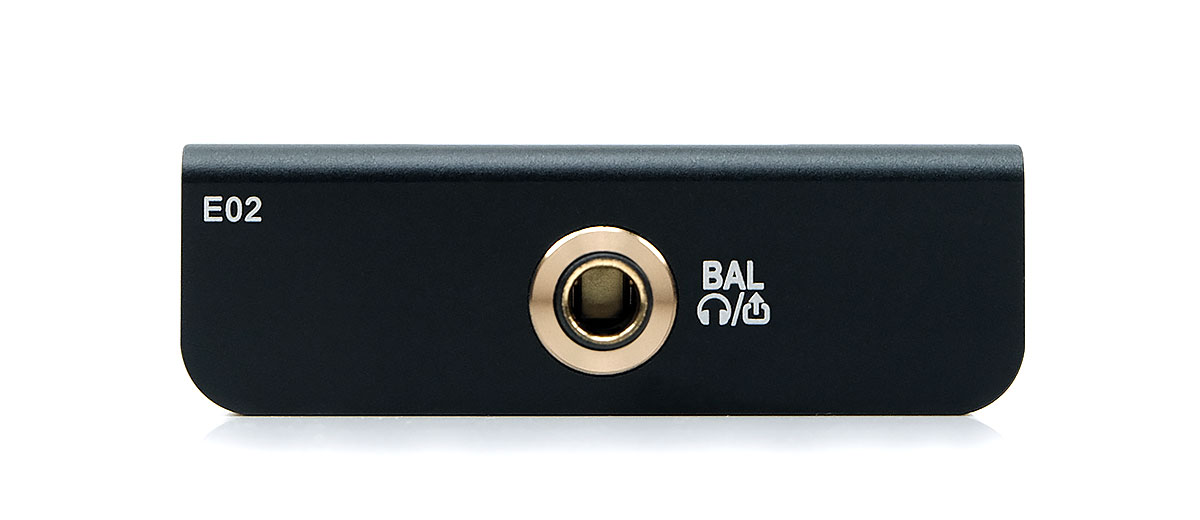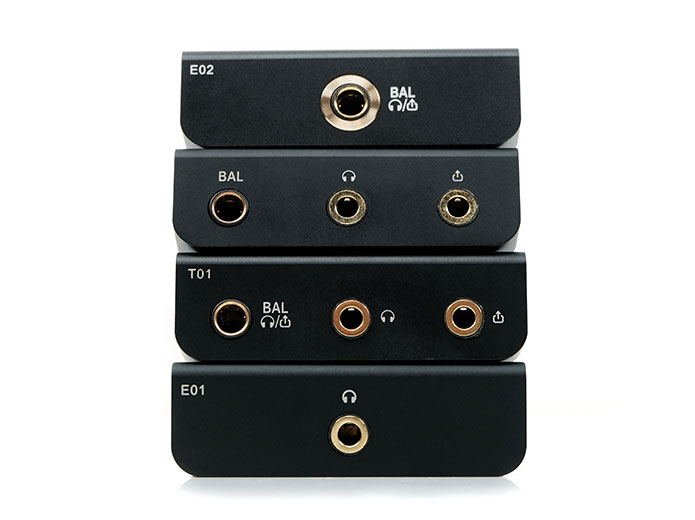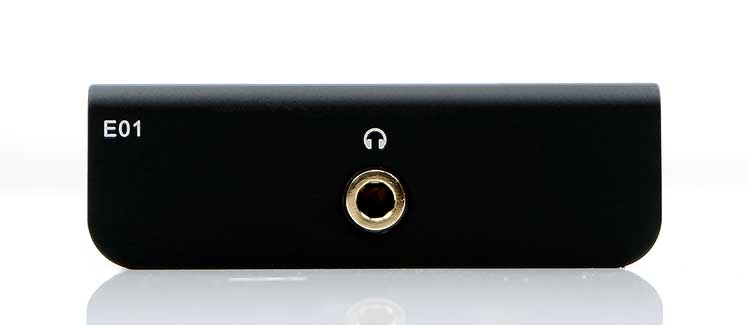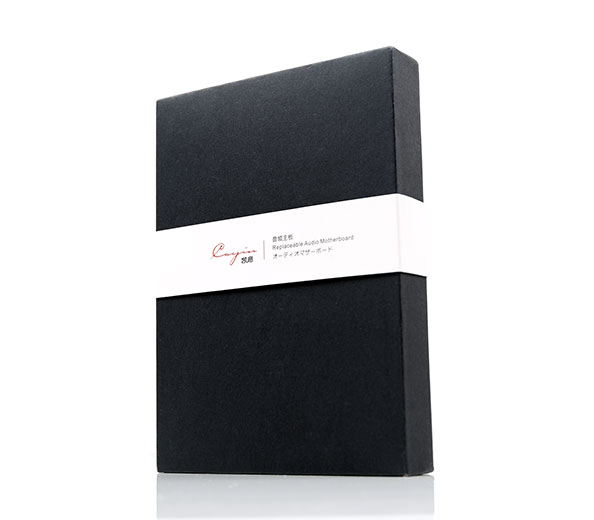Cayin E02 Synergy
Efficiency
Going balanced and injecting more power does mean the E02 has a higher noise floor than the E01 for efficient monitors. You will detect it fairly readily at low volume with the likes of the Campfire Audio Solaris SE, Andromeda, and the Empire Ears Zeus which are hyper-sensitive. You can also detect it on the E01 but it is less invasive.
However, the noise floor drops once you switch to less efficient monitors and you do have plenty of adjustable current parameters to get a good grip on the volume control. Even with sensitive monitors, the E02 on low-gain will give you a good 30-35 steps on the Solaris and slightly less with the Zeus. It is not an aggressive current release which, to be frank, I was kind of expecting. That is a definitive positive.
With monitors like the Noble Audio Khan and harder to drive electrostatic hybrids like the Vision Ears Elysium, you will get a bit more headroom than the E01 but also a pitch-black background, especially with the Khan. Channel balancing on the Khan is excellent with next to no channel bias when going through the gears.
Power
This is where the E02 makes its mark but it is not just about brute force here. You may be interested to know that the 150mW output of the Class AB E01 holds up reasonably well compared to the E02 with loads of 32-50Ω. By that I mean headphones like the SendyAudio Aiva, Ether 2 from Dan Clark Audio, the Meze Empyrean, and Audeze’s LCD-X will not collapse like a deck of cards.
However, the dynamic range and headroom of the E02 are better, and that almost always translated into a bit more “verve” in the response of each of the headphones tested. Combine that with the planted low-end and denser sounding vocal of the E02 and I felt this motherboard was way more suited to the likes of the LCD-X compared to the T01 and A01 options.
These two cards either lacked a bit of vividness or felt too bright as such was the case with the T01 and the LCD-X. The T01 came more into its own with the Empyrean’s warmer signature with a little bit more sparkle up top than the E02. However, it lacks a little bit of depth offering instead more of a ‘hi-fidelity’ tone to the tested headphones.
The E02 is not as bright and instead adds that necessary low-end weight, better separation, and generally a more engaging sound. The LCD-X treble was also more even sounding with less unnatural sibilance creeping into the LCD-X vocals.
For those thinking that the FiiO M15 has more power in its 4.4mm output, I do agree on that statement but it is a very different presentation. The M15 is much the cleaner and more neutral sounding of the two amp outputs. The E02 has a denser more physical sound, a fuller vocal, and less ‘analytical’ in its delivery.
Select Comparisons
Cayin A01
$299
Technical
The A01 is the first motherboard and came packaged with the N6ii. You can now buy it separately and it is the cheapest of the current motherboards on offer at $299. With both balanced PO and LO as well as unbalanced PO/LO you can consider this to be a good all-rounder motherboard with a better battery life of 14 hours balanced compared to the E02’s 9.5-hour rating.
The A01 uses a single AKM AK4497 DAC chipset compared to the E02’s higher-end dual ES9028Q2M implementation. On the decoding side, they offer the same capability at up to DSD 256 and PCM 32BIT/284kHz though, for me, the ES9038Q2M has a better dynamic range capability and it shows in their comparative specs with a gap of around 2-3dB.
The A01 motherboard also offers a balanced 4.4mm line-out set at 2V, 3V, and 4.3V (balanced) which is close to the 2., 3.1, and 4.2V of the E02. However, it is not a true line-out but rather coursed through amp stage and therefore you are double amping.
The E02 is dedicated and a clean LO balanced signal so it will shed a lot of noise. The potential crosstalk performance on the E02 is better with its discreet design and dual DAC implementation at 106dB. That is 6dB more than the A01’s balanced output.
However, it is the output power of the E02 that is probably the key selling point here at 600mW into 32Ω which is ahead of the A01’s 530mW into the same load balanced. The E02’s THD+N does take a knock comparatively speaking but the noise performance is still very competitive for the level of power at your disposal.
Tuning
The A01 and E02 go for a fairly similar timbral offering, a natural to warm sound with a smooth vocal and top-end delivery. There are a few immediate differences between these two amp cards, namely power, and dynamic range capability.
This is especially so if you are working both cards with less efficient headphones such as Dan Clark Audios’ Ether 2 or Audeze’s LCD-X that both float around the 100dB SPL level. Both of these headphones won’t have an issue with the high gain setting of the E02.
Beyond that, these 2 motherboards do have some more nuanced timbral variations that, combined with that dynamic range, help push the E02 ahead of the A01.
The first thing the E02 has a tendency to do when compared to the A01 is to make the former sound a bit ‘samey’ and more intimate. That’s the dynamic range for me combined with better channel separation which produces a much deeper and more complex presentation. The A01 feels a little controlled by comparison with a softer low-end and a more compressed o intimate midrange.
The better driving capability of the E02 over the A01 does play an important role in those differences so whilst I still term the E02 signature as smooth, it is much more open with a deeper and more solid bass response and better treble headroom with headphones that can scale. All of this contributes to a more vivid E02 presentation without resorting to cheap parlor tricks like a forced treble or a shouty midrange.

Cayin T01
$339
Technical
The T01 was Cayin’s second motherboard card and more of a homage to the original N6 DAP than breaking any new technological boundaries. The T01 uses the same dual DAC current mode PCM1792 chipset from the original N6 and compared to the dual ES9038Q2M of the E02 it does have some technical limitations.
The T01 is limited to 24BIT/192kHz PCM compared to 32BIT/385kHz on the E02. Anything higher in PCM on the T01 will be downsampled. However, the T01 can actually natively decode up to DSD256 which is the same top-level decoding capability as the E02.
The T01 is capable of a balanced 4.4mm output at 530mW on a 32Ω load which is similar to the A01’s output but both are behind the 600mW 32Ω load of the E02’s balanced output. At full output, the T01 is also less efficient with a higher battery drain at just 7.5 hours maximum compared to the 9.5 hours on the E02.
The dynamic range of the T01 balanced output is also a bit behind at 116dB compared to the E02’s 121dB. Both offer variable LO output at 2.2, 3.2, and 4.2V though again the T01 dynamic range lags a little compared to the E02 and the T01’s LO is an amplified 4.4mm LO (double amping) and not a true balanced LO like the E02.
Tuning
Whilst I think the T01 is at least as expansive as the E02 when using both in balanced mode, there are some very definite timbral differences and some very clear choices as a result.
Now, when it comes to power, the E02 still has an edge but unlike the A01, the T01 is not an intimate or slightly soft-sounding presentation. The T01 has a brighter overtone with more treble presence than the E02 and that creeps down into the vocal and instrumental timbre.
As a consequence, the T01 retains excellent headroom, on par with the E02 but on the flipside its harmonic balance it lighter with more odd-harmonic presence that can create an edge on vocal delivery.
Natural sibilance is slightly more emphasized though still fairly well controlled whereas the E02 is definitely wetter with a gentler attack and slightly longer decay. Vocals have that ‘juicer’ full-bodied sound to them on the E02 where they tend to be more fleet-footed and lighter in density on the T01.
Some of that ‘lightness’ comes from the linear bias on the low-end of the T01. The E02 does sound the weightier and more planted of the two cards and that translates to an enhanced lower-mids body and a richer timbre for rhythmic instrumental passages as well as the voicing differences described above.
Preferences
If you are trying to pair one or the other I would hesitate to pair the T01 with any headphone that has an emphasized lower treble. On the LCD-X the natural sibilance percussion presence was overly emphasized with a lack of low-end weight that made it fatiguing. The E02 is much better suited to these types of signatures producing a feisty but more natural and planted tone.
On the flip side, the T01 does well with darker sound signatures such as the Empyrean and Ether 2 and both can be driven well with the T01. The E02 will add a bit more “drive” to the signature of both headphones and some additional midrange body but the treble will sound a shade more relaxed.
Cayin E01
$419
Technical
I do think the E01 and E02 offer two very clear choices as motherboards for the N6ii. However, they also have some shared characteristics. Both motherboards do use a discreet topology and both offer up to 9.5-hours battery life.
Where they differ is in their amplification and DAC. The E01 is unbalanced only and the E02 is balanced 4.4mm only – a clear divide. The E01, however, features a dual operational mode amplifier with both Class A and Class AB output whereas the E02 is Class AB only.
The maximum output rating of the E01 is 105mW for Class A and 150mW for Class AB into a 32Ω compared to the much higher 600mW single 32Ω load rating of the E02. Right away, the E02 is going to be more suited to demanding headphones than the E01’s AB output.
The other key feature missing from the E01 is a line-out option that the E02 now has with 3 separate voltage settings depending on your needs. The E02 will be the appropriate choice if you wish to hook up the N6ii as your source to a desktop or portable amplifier.
Both use Sabre DACs, however, the E01 uses an ES9038PRo chipset which is desktop-class. The E02 goes for a mobile-class stereo Q2M version but in a dual DAC independent channel implementation which allows it to achieve those matching battery specifications. Both will decode up to DSD256 and PCM 32BIT/384kHz.
Performance
The E01 has 2 sound signatures and both are on much-reduced unbalanced power outputs, (up to 150mW), compared to the single balanced Class AB E02 (600mW).
Now, I did remark in my E01 review that the spec’ed output power of the E01 was a little deceiving in terms of how well headphones could pair with it. And true enough, with the likes of the Ether 2, the E01 performs quite well though the current and dynamic range gap between the two motherboards is noticeable (15-20 steps on high gain).
The timbre between these two has a more nuanced difference which shouldn’t be surprising. For headphone users, it is going to be the dynamic range again but not a big gap like the A01. For IEM users, a slight softness and a bit more diffuse in imaging in the E01 with less bass weight, (Noble Khan). There also seems to be a slightly longer timbral decay on the notes using the E01 compared to the E02 on richer headphones like the Ether 2.
The E02 has the punchier signature but that low-end remains tight, perhaps tighter than the E01. It’s channel separation, especially on headphones, is a little better than the E01 with more staging width and superior instrumental separation.
It does feel that the decay is marginally shorter on the E02 with a tone marginally more solid-state than SET but still quite natural. What I mean by that is it feels more energetic, faster, and with a harmonic balance that shows off a bit more odd-harmonic presence. The E01, by contrast, has a bit more of a sweeter overtone on vocals and a wetter percussion delivery.
Our Verdict
The E02 is easily the most dynamic sounding and Cayin’s most powerful motherboard to date for the N6ii. Those looking for a balanced LO or PO solution and trying to work some good quality headphones into their daily listening habits should get plenty of reward from the E02/N6ii pairing.
IEM users should not feel left out either. My initial assumption that the E02 was all about power is misplaced as the current demand is nuanced enough to work with all but the most hiss-sensitive monitors out there. Pairing is flexible enough but my guess is the real reward is the synergy with headphones where the separation and dynamic range can be most felt.
Whilst the M15 from FiiO has the edge in 4.4mm balanced power by some 200mW into the same load I do think that Cayin has delivered a motherboard that sounds very different and likely to appeal to those who want something a bit ‘juicer’ and powerful sounding.
In all, the E02 keeps the N6ii pleasing fresh and relevant which can often be a hard thing to do for a DAP in this rapidly evolving niche.
Cayin E02 Specifications
- High-performance Dual DAC setup, featuring dual ES9038Q2M DAC
- Four-Way I/V Conversion
- Four-Way Discrete Component Powerful Amplification
- Output Power PO
- 600mW at 32Ω
- 137mW at 150Ω
- 69mW at 300Ω
- Three Level Line out mode, High, Medium, Low
- Output Power LO
- 4.1V @ 10kΩ, High
- 3.2V @ 10kΩ, Medium
- 2.1V @ 10kΩ, Low
- THD+N: 0.001%
- Dynamic Range: 121dB
- Signal to Noise Ratio: 121dB
- Separation: 106dB
- Battery Life of up to 9.5 hours





